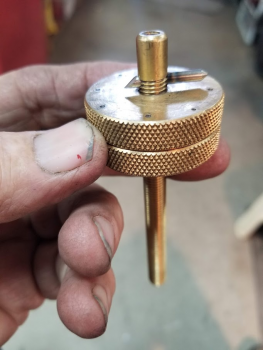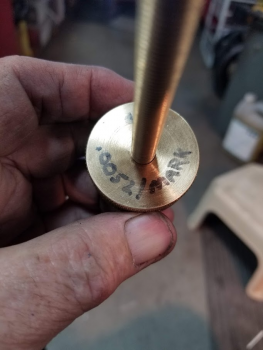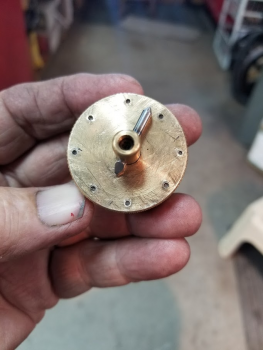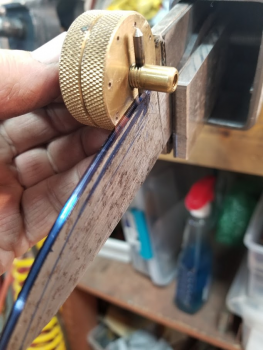MTBob
Well-Known Member
Oddly In my machine shop I've never had a granite block or height gauge. I've mostly been too cheap to get the setup and have figured out ways to work around the need.
But, there is a need to mark the center line on a knife edge before grinding. It doesn't have to be real accurate, but pretty close, say +/- .002 or so (I think). Hum.... let's see how would I make something that would make an edge mark with kind of accuracy, without a lot of fooling around? No doubt there are dozens of tools that will do this with more accuracy, but hey, it's more fun to make my own tools rather than buy them... sometimes.
Well, using a 24 pitch thread, one revolution = .0416, or say, .042" So, if I made something that divided one full revolution into increments (say, 8 increments) each one would represent .0052" (.042/8=.0052"). Here's what I came up with.
This is a 5/16-24 threaded rod with two large knurled jam nuts. The marking piece is hardened O1 tool steel. The upper nut has 8 dividing marks.

As I said, one mark equals .0052"

Using .0052" per mark, it's a simple calculation to get the number of marks to move the upper nut. In this case the blade is .118" thick and I wanted a .020" gap scribe. So I rotated the nut 9.4 marks..

Rotate and tighten the lower nut and it holds the setting in place.
And yes, it's not perfect. But, it's within a couple thousandths at most.

Here's the result

I used a lathe to make this tool. But, with a little McGiver'in a simple 5/16-24 bolt, nut and washer would likely work too. (Using this rotation and dividing design most any fine thread could be used).
If I made another one, I'd probably make the nuts a little larger in diameter to more easily lay flat on the side of a knife blade.
But, there is a need to mark the center line on a knife edge before grinding. It doesn't have to be real accurate, but pretty close, say +/- .002 or so (I think). Hum.... let's see how would I make something that would make an edge mark with kind of accuracy, without a lot of fooling around? No doubt there are dozens of tools that will do this with more accuracy, but hey, it's more fun to make my own tools rather than buy them... sometimes.
Well, using a 24 pitch thread, one revolution = .0416, or say, .042" So, if I made something that divided one full revolution into increments (say, 8 increments) each one would represent .0052" (.042/8=.0052"). Here's what I came up with.
This is a 5/16-24 threaded rod with two large knurled jam nuts. The marking piece is hardened O1 tool steel. The upper nut has 8 dividing marks.

As I said, one mark equals .0052"

Using .0052" per mark, it's a simple calculation to get the number of marks to move the upper nut. In this case the blade is .118" thick and I wanted a .020" gap scribe. So I rotated the nut 9.4 marks..

Rotate and tighten the lower nut and it holds the setting in place.
And yes, it's not perfect. But, it's within a couple thousandths at most.

Here's the result

I used a lathe to make this tool. But, with a little McGiver'in a simple 5/16-24 bolt, nut and washer would likely work too. (Using this rotation and dividing design most any fine thread could be used).
If I made another one, I'd probably make the nuts a little larger in diameter to more easily lay flat on the side of a knife blade.

